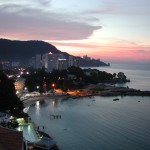Experts are divided on whether Malaysia’s economy would improve or deteriorate in the year of the fire rooster compared to the volatile period during 2016.
According to RAM Ratings economist Kristina Fong, the country’s gross domestic product (GDP) could expand by 4.5 percent in 2017, up from the estimated 4.2 percent in the preceding year, thanks to healthy salary growth amidst better labour conditions and resilient domestic demand.
“We also see upside in the trade indicators, which points to some stabilisation in the external demand,” she told the media after launching the RAM Business Confidence Index on Tuesday (10 January).
On the other hand, Standard Chartered Bank’s head of economic research in Southeast Asia, Edward Lee, believes that Malaysia’s GDP could register a slower growth of 3.8 percent this year versus the estimated 4.0 percent in 2016.
“The slight moderation is mainly from the consumer side. I do see the softening in the labour market and of course the pick up in inflation,” he told reporters during his firm’s latest Global Research Briefing yesterday.
Lee is less optimistic on the economy due to an uptick in inflation and the jobless rate, as well as a cool down in employment growth, which are projected to impact consumption and actual salary growth.
While consumption fared better than expected last year which helped bolster economic growth, it was partly attributed to one-time measures, such as a minimum wage hike and a voluntary reduction in EPF contributions.
“I think the wealth effect has been slowly easing off over the last one to two years. For example, (in) the property market, while it is still a positive year-on-year in terms of price increase, that increase has been slowing down. On consumption, I don’t think it is going to remain as strong but will still be a big contributor to growth,” added Lee.
Meanwhile, the Malaysian ringgit’s exchange rate against the US dollar is expected to weaken to 4.6 in June 2017, before strengthening to 4.3 by early-2018, said Standard Chartered Bank’s Divya Devesh.
The foreign exchange strategist for South Asia and the ASEAN region feels the local currency could be dragged down in the first half of the year, in light of lower market liquidity.
“Exporters have been reluctant to sell dollars for the past year or two. That has made onshore demand-supply extremely one-sided,” he noted. Nevertheless, he added that the exchange rate is unlikely to go beyond 4.6 as the country’s economic fundamentals are still robust and valuations remain attractive.
Image sourced from Wikisabah
Diane Foo Eu Lynn, Senior Content Specialist at PropertyGuru, edited this story. To contact her about this or other stories email diane@propertyguru.com.my




